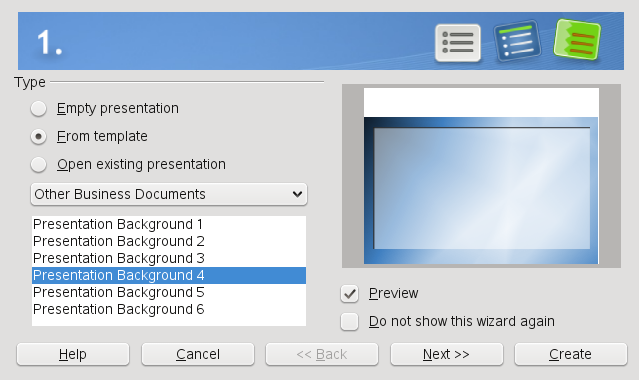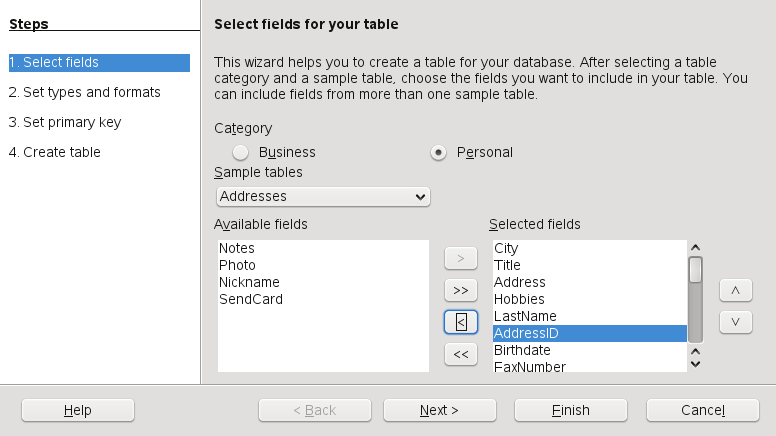Contents
Besides OpenOffice.org Writer and OpenOffice.org Calc, OpenOffice.org also includes the modules Impress, Base, Draw, and Math. With these you can create presentations, design databases, draw up graphics and diagrams, and create mathematical formulas.
Use OpenOffice.org Impress to create presentations for screen display or printing, such as slide shows or transparencies. If you have used other presentation software, you can move comfortably to Impress, which works very similarly to other presentation software.
Impress can open and save Microsoft Powerpoint presentations. This means you can exchange presentations with Powerpoint users, as long as you save your presentations in Powerpoint format.
The Novell edition of OpenOffice.org allows you to use 3D transitions for your slides. Access the available transitions by selecting +.
You can either create a new presentation from scratch (without any preformatted slides) or use an existing template or presentation for your new document. Impress uses styles and templates the same way other OpenOffice.org modules do. See Section 1.9, “Using Templates” for more information about templates. A wizard leads you through the available options for creating new presentations.
Start OpenOffice.org Impress directly or in OpenOffice.org, click ++.
Select one of the options for creating a new presentation.
If you decide to create a presentation from a template, choose one of the templates from the drop-down list and click .

From a variety of backgrounds and ready-made presentations, select a slide design. To create your own design, select .
Select an output medium. The output medium is the form the final presentation will take, such an overhead sheet, paper, or a screen slide show, among other choices.
Select for a thumbnail showing your choices. If all options are set according to your wishes, click .
If you want to use effects for slide transitions, select the you want to use and specify the .
Either use the default presentation type or choose to specify the amount of time each page displays and the length of the pause between presentations.
If all options are set according to your wishes, click .
The presentation opens, ready for editing.
Master pages give your presentation a consistent look by defining the way each slide looks, what fonts are used, and other graphical elements. Impress uses two types of master pages:
- Slide Master
Contains elements that appear on all slides. For example, you might want your company logo to appear in the same place on every slide. The slide master also determines the text formatting style for the heading and outline of every slide that uses that master page, as well as any information you want to appear in a header or footer.
- Notes Master
Determines the formatting and appearance of the notes in your presentation.
Impress comes with a collection of preformatted master pages. Eventually, most users will want to customize their presentations by creating their own slide masters.
Start Impress, then create a new empty presentation.
Click ++.
This opens the current slide master in .
Right-click the left-hand panel, then click .
Edit the slide master until it has the desired look.
Click or + to return to .
![[Tip]](admon/tip.png) | |
When you have created all of the slide masters you want to use in your presentations, you can save them in an Impress template. Then, any time you want to create presentations that use those slide masters, open a new presentation with your template. | |
Slide masters can be applied to selected slides or to all slides in the presentation.
Open your presentation, then click ++.
(Optional) If you want to apply the slide master to multiple slides, but not to all slides. Select the slides that you want to use that slide master.
To select multiple slides, pressCtrl in the while clicking on the slides you want to use.
In the Tasks Pane, right-click the master page you want to apply.
If you do not see the , click +.
Apply the slide master by clicking one of the following:
- Apply to All Slides
Applies the selected slide master to all slides in the presentation.
- Apply to Selected Slides
Applies the selected slide master to the current slide, or to any slides you select before applying the slide master. For example, if you want to apply a different slide master to the first slide in a presentation, select that slide, then change to and apply a slide master to that slide.
OpenOffice.org includes a database module: Base. Use Base to design a database to store many different kinds of information, from a simple address book or recipe file to a sophisticated document management system.
Tables, forms, queries, and reports can be created manually or by using convenient wizards. For example, the Table Wizard contains a number of common fields for business and personal use. Databases created in Base can be used as data sources, such as when creating form letters.
It is beyond the scope of this document to detail database design with Base. More information can be found at the sources listed in Section 1.10, “For More Information”.
Base comes with several predefined database fields to help you create a database. A wizard guides you through the steps to create a new database. The steps in this section are specific to creating an address book using predefined fields, but it should be easy to follow them to use the predefined fields for any of the built-in database options.
The process for creating a database can be broken into several subprocesses:
Click ++.
Select +.
Click to make your database information available to other OpenOffice.org modules, select both check boxes in the bottom half of the dialog, then click .
Browse to the directory where you want to save the database, specify a name for the database, then click .
Next, define the fields you want to use in your database table.
In the , click .
The list changes to show the predefined tables for personal use. If you had clicked , the list would contain predefined business tables.
In the list, click .
The available fields for the predefined address book appear in the menu.
In the menu, click the fields you want to use in your address book.
You can select one item at a time, or you can shift-click multiple items to select them.
Click the single arrow icon to move the selected items to the menu.
To move all available fields to the menu, click the double right-arrow.
Use the ↑ and ↓ keys to adjust the order of the selected fields.
The fields appear in the table and forms in the order in which they are listed.

Click .
Make sure each of the fields is defined correctly.
You can change the field name, type, maximum characters and whether it is a required field. For this example, leave the settings as they are.
Click .
Click , click , click , then click .
Accept the default name for the table, select , then click .
Next, create the form to use when entering data into your address book.
In the , click the double right-arrow icon to move all available fields to the list, then click twice.
Select if you want to add a subform, then click .
For this example, accept the default selections.
Select how you want to arrange your form, then click .
Select the option to use the form to display all data and leave all of the check boxes empty, then click .
Apply a style and field border, then click .
For this example, accept the default selections.
Name the form, select the option, then click .
After the form has been defined, you can modify the appearance of the form to suit your preferences.
Close the form that opened when you finished the previous step.
In the main window for your database, right-click the form you want to modify (there should be only one option), then click .
Arrange the fields on the form by dragging them to their new locations.
For example, move the First Name field so it appears to the right of the Last Name field, and then adjust the locations of the other fields to suit your preference.
When you have finished modifying the form, save it and close it.
After you have created your database tables and forms, you are ready to enter your data. You can also design queries and reports to help sort and display the data.
Refer to OpenOffice.org online help and other sources listed in Section 1.10, “For More Information” for additional information about Base.
Use OpenOffice.org Draw to create graphics and diagrams. You can save your drawings in today’s most common formats and import them into any application that lets you import graphics, including the other OpenOffice.org modules. You can also create Flash versions of your drawings.
The OpenOffice.org documentation contains complete instructions on using Draw. See Section 1.10, “For More Information” for more information.
The Novell edition of OpenOffice.org allows you to import Scalable Vector Graphics (*.svg) and WordPerfect Graphics (*.wpg). Select + and use the drop-down list to view which file formats can be opened.
Procedure 4.1. Creating a Graphic
Press Alt+F2 and enter oodraw to open OpenOffice.org Draw.
Use the toolbar at the bottom of the window to create a graphic.
Save the graphic.
To embed an existing Draw graphic into an OpenOffice.org document, select ++. Select and click to navigate to the Draw file to insert. If you insert a file as OLE object, you can easily edit the object later by double-clicking it.
Procedure 4.2. Opening Draw From Other OpenOffice.org Modules
One particularly useful feature of Draw is the ability to open it from other OpenOffice.org modules so you can create a drawing that is automatically imported into your document.
From an OpenOffice.org module (for example, from Writer), click ++++.
This opens Draw.
Create your drawing.
Click in your document, outside the Draw frame.
The drawing is automatically inserted into your document.
It is usually difficult to include complex mathematical formulas in your documents. The OpenOffice.org Math equation editor lets you create formulas using operators, functions, and formatting assistants. You can then save those formulas as objects that can be imported into other documents. Math functions can be inserted into other OpenOffice.org documents like any other graphic object.
![[Note]](admon/note.png) | |
Math is not a calculator. The functions it creates are graphical objects. Even if they are imported into Calc, these functions cannot be evaluated. | |